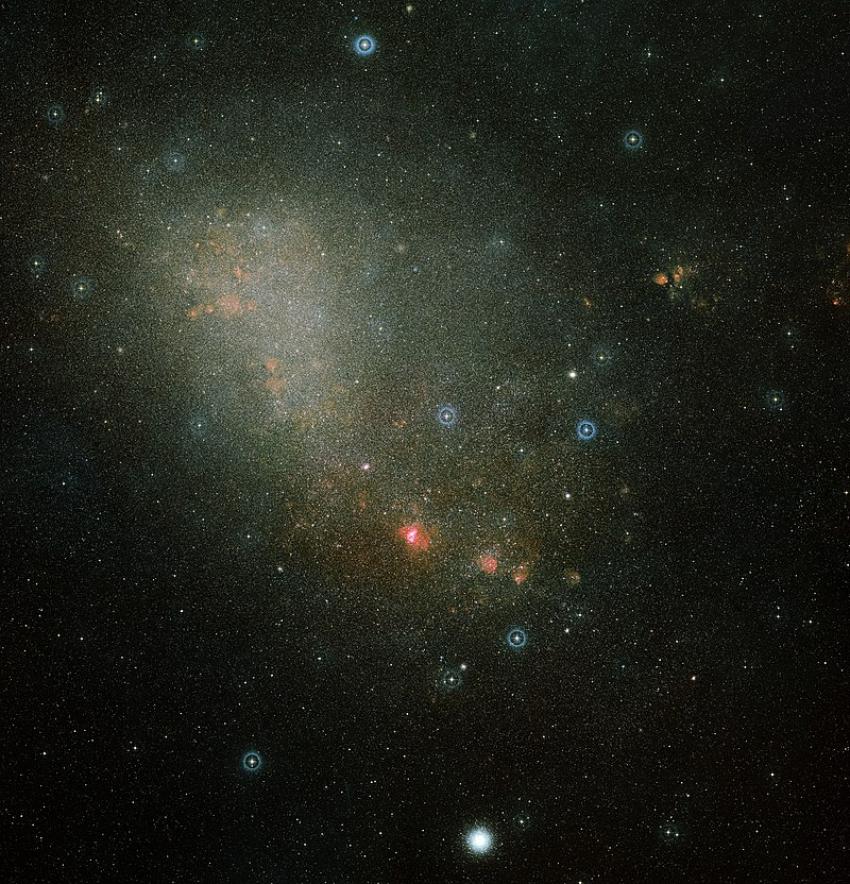There are hundreds of billions of galaxies in the Universe, each containing billions of stars, and found in every part of the sky. But in some directions, nearby galaxies block the view of the more distant cosmos. Now a team from the University of Keele have created the largest ever map of previously hidden galaxies. Jessica Craig is presenting their work this week at the National Astronomy Meeting at the University of Warwick.
The astronomers looked at the Magellanic Clouds, a pair of galaxies visible from the southern hemisphere that are so close to us that they can be seen with the naked eye. The two galaxies take up a large area of sky, blocking the view of galaxies further away. Because of this, astronomers looking for distant galaxies usually avoid this part of the sky.
Using the VISTA Survey Telescope in Chile, the team photographed the two nearby galaxies in high enough definition to be able to look through the gaps between stars in each one. That way they could see more distant galaxies, which appear fainter and redder than they really are due to the dust that is still in front of them.
The solution is to use a radio telescope, and in this case the Galactic Australian Square Kilometer Array Pathfinder Survey (GASKAP) gives a detailed map of the gas in the Magellanic Clouds, allowing the dust content to be measured, and hence how much the stars are reddened.
A further concern is to distinguish stars from galaxies, and there are so many that this would be impossible by hand. So the Keele team used data from the Gaia observatory to measure the tiny shifts in the positions of stars over time, while the much more distant galaxies stayed in the same place. Galaxies are also redder than the brighter stars, so colour helped remove more stars from the dataset. Colour also indicates how far away galaxies are (through their redshift resulting from the expansion of the Universe).
Machine learning, where software uses artificial intelligence tools, is doing the final sort of the rest of the data. All of this work is leading to the largest ever 3D map of galaxies previously hidden behind the Magellanic Clouds, covering an estimated 1 million galaxies.
Jessica Craig comments: "The Magellanic Clouds are beautiful galactic companions, but they unfortunately do block part of our view of objects further out. Our work is helping overcome that, and in the process helping to fill in the gaps in our map of the universe."
Media contacts
Dr Robert Massey
Royal Astronomical Society
Mob: +44 (0)7802 877699
nam-press@ras.ac.uk
Gurjeet Kahlon
Royal Astronomical Society
Mob: +44 (0)7802 877700
nam-press@ras.ac.uk
Cait Cullen
Royal Astronomical Society
nam-press@ras.ac.uk
Science contacts
Jessica Craig
University of Keele
j.e.m.craig@keele.ac.uk
Images and captions
Image 1: https://nam2022.org/images/800px-Small_Magellanic_Cloud_Digitized_Sky_Survey_2.jpg
The Small Magellanic Cloud, in a composite made from two images from the Digitized Sky Survey 2. Credit: ESA/Hubble and Digitized Sky Survey 2. Acknowledgements: Davide De Martin (ESA/Hubble)
Image 2: https://nam2022.org/images/Screenshot_21_WithCircles.png
A section of the Small Magellanic Cloud in an image made with the VISTA telescope. Some of the more distant galaxies are circled in green. Credit: ESO/VISTA Magellanic Clouds Survey, Acknowledgements: Mike Read and Cambridge Astronomical Survey Unit
Notes for editors
About NAM 2022
The NAM 2022 conference is principally sponsored by the Royal Astronomical Society (RAS), the Science and Technology Facilities Council (STFC) and the University of Warwick. Keep up with the latest conference news on Twitter.
About the Royal Astronomical Society
The Royal Astronomical Society (RAS), founded in 1820, encourages and promotes the study of astronomy, solar-system science, geophysics and closely related branches of science. The RAS organises scientific meetings, publishes international research and review journals, recognises outstanding achievements by the award of medals and prizes, maintains an extensive library, supports education through grants and outreach activities and represents UK astronomy nationally and internationally. Its more than 4,000 members (Fellows), a third based overseas, include scientific researchers in universities, observatories and laboratories as well as historians of astronomy and others.
Follow the RAS on Twitter, Facebook, Instagram and YouTube. Listen and subscribe to the Supermassive Podcast here.
About the Science and Technology Facilities Council
The Science and Technology Facilities Council (STFC) is part of UK Research and Innovation – the UK body which works in partnership with universities, research organisations, businesses, charities, and government to create the best possible environment for research and innovation to flourish. STFC funds and supports research in particle and nuclear physics, astronomy, gravitational research and astrophysics, and space science and also operates a network of five national laboratories, including the Rutherford Appleton Laboratory and the Daresbury Laboratory, as well as supporting UK research at a number of international research facilities including CERN, FERMILAB, the ESO telescopes in Chile and many more.
STFC's Astronomy and Space Science programme provides support for a wide range of facilities, research groups and individuals in order to investigate some of the highest priority questions in astrophysics, cosmology and solar system science. STFC's astronomy and space science programme is delivered through grant funding for research activities, and also through support of technical activities at STFC's UK Astronomy Technology Centre and RAL Space at the Rutherford Appleton Laboratory. STFC also supports UK astronomy through the international European Southern Observatory and the Square Kilometre Array Organisation.
Follow STFC on Twitter.
About the University of Warwick
The University of Warwick is one of the world’s leading research institutions, ranked in the UK’s top 10 and world top 80 universities. Since its foundation in 1965 Warwick has established a reputation of scientific excellence, through the Faculty of Science, Engineering and Medicine (which includes WMG and the Warwick Medical School).


